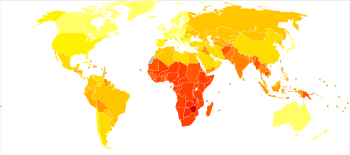
Back عبء المرض Arabic Càrrega de la malaltia Catalan Krankheitslast German Carga de enfermedad Spanish Charge de morbidité French Carico di malattia Italian 疾病負荷 Japanese 질병부담 Korean Ziektelast Dutch Breme bolezni Slovenian


Disease burden is the impact of a health problem as measured by financial cost, mortality, morbidity, or other indicators. It is often quantified in terms of quality-adjusted life years (QALYs) or disability-adjusted life years (DALYs). Both of these metrics quantify the number of years lost due to disability (YLDs), sometimes also known as years lost due to disease or years lived with disability/disease.[1] One DALY can be thought of as one year of healthy life lost, and the overall disease burden can be thought of as a measure of the gap between current health status and the ideal health status (where the individual lives to old age without disease and disability).[2][3][4] According to an article published in The Lancet in June 2015, low back pain and major depressive disorder were among the top ten causes of YLDs and were the cause of more health loss than diabetes, chronic obstructive pulmonary disease, and asthma combined. The study based on data from 188 countries, considered to be the largest and most detailed analysis to quantify levels, patterns, and trends in ill health and disability, concluded that "the proportion of disability-adjusted life years due to YLDs increased globally from 21.1% in 1990 to 31.2% in 2013."[5] The environmental burden of disease is defined as the number of DALYs that can be attributed to environmental factors.[4][6][7] Similarly, the work-related burden of disease is defined as the number of deaths and DALYs that can be attributed to occupational risk factors to human health.[8] These measures allow for comparison of disease burdens, and have also been used to forecast the possible impacts of health interventions. By 2014, DALYs per head were "40% higher in low-income and middle-income regions."[9]
The World Health Organization (WHO) has provided a set of detailed guidelines for measuring disease burden at the local or national level.[4] In 2004, the health issue leading to the highest YLD for both men and women was unipolar depression;[10] in 2010, it was lower back pain.[11] According to an article in The Lancet published in November 2014, disorders in those aged 60 years and older represent "23% of the total global burden of disease" and leading contributors to disease burden in this group in 2014 were "cardiovascular diseases (30.3%), malignant neoplasms (15.1%), chronic respiratory diseases (9.5%), musculoskeletal diseases (7.5%), and neurological and mental disorders (6.6%)."[9]: 549
- ^ "WHO | Metrics: Disability-Adjusted Life Year (DALY)". WHO. Retrieved 2020-01-02.
- ^ Prüss-Üstün, Annette; Corvalán, Carlos (2006). "Preventing disease through healthy environments: Towards an estimate of the environmental burden of disease" (PDF). Quantifying environmental health impacts. World Health Organization.
- ^ Kay, David; Prüss, Annette; Corvalán, Carlos (23–24 August 2000). "Methodology for assessment of Environmental burden of disease" (PDF). ISEE session on environmental burden of disease. Buffalo.
- ^ a b c Prüss-Üstün, Annette; Mathers, C.; Corvalán, Carlos; Woodward, A. (2003). Assessing the environmental burden of disease at national and local levels: Introduction and methods. WHO Environmental Burden of Disease Series. Vol. 1. Geneva: World Health Organization. ISBN 978-9241546201. Archived from the original on June 12, 2005.
- ^ "Global, regional, and national incidence, prevalence, and years lived with disability for 301 acute and chronic diseases and injuries in 188 countries, 1990–2013: a systematic analysis for the Global Burden of Disease Study 2013". The Lancet. 386 (9995): 743–800. 8 June 2015. doi:10.1016/S0140-6736(15)60692-4. PMC 4561509. PMID 26063472.
- ^ Knol AB, Petersen AC, van der Sluijs JP, Lebret E (1 January 2009). "Dealing with uncertainties in environmental burden of disease assessment". Environmental Health. 8 (1): 21. Bibcode:2009EnvHe...8...21K. doi:10.1186/1476-069X-8-21. PMC 2684742. PMID 19400963.
- ^ Briggs, D. (1 December 2003). "Environmental pollution and the global burden of disease". British Medical Bulletin. 68 (1): 1–24. doi:10.1093/bmb/ldg019. PMID 14757707.
- ^ Pega, Frank; Nafradi, Balint; Momen, Natalie; Ujita, Yuka; Streicher, Kai; Prüss-Üstün, Annette (2021). "Global, regional, and national burdens of ischemic heart disease and stroke attributable to exposure to long working hours for 194 countries, 2000–2016: A systematic analysis from the WHO/ILO Joint Estimates of the Work-related Burden of Disease and Injury". Environment International. 154: 106595. Bibcode:2021EnInt.15406595P. doi:10.1016/j.envint.2021.106595. ISSN 0160-4120. PMC 8204267. PMID 34011457.
- ^ a b Martin J Prince; Fan Wu; Yanfei Guo; Luis M Gutierrez Robledo; Martin O'Donnell; Richard Sullivan; Salim Yusuf (2015). "The burden of disease in older people and implications for health policy and practice". The Lancet. 385 (9967): 549–62. doi:10.1016/S0140-6736(14)61347-7. PMID 25468153. S2CID 1598103.
- ^ World Health Organization (WHO) (2004). "Disease incidence, prevalence and disability" (PDF). The Global Burden of Disease. Retrieved 2009-01-30.
- ^ Vos, T (Dec 15, 2012). "Years lived with disability (YLDs) for 1160 sequelae of 289 diseases and injuries 1990–2010: a systematic analysis for the Global Burden of Disease Study 2010". Lancet. 380 (9859): 2163–96. doi:10.1016/S0140-6736(12)61729-2. PMC 6350784. PMID 23245607.